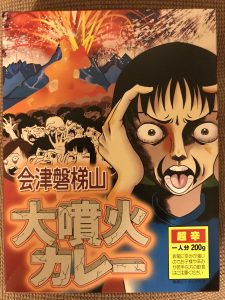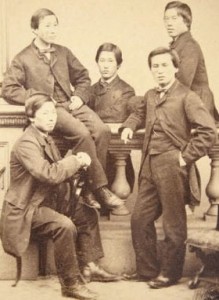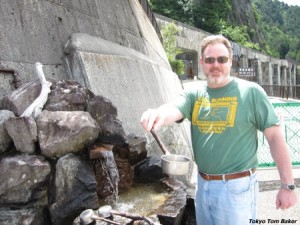Around Japan in 47 curries: Fukushima fire curry
Tom Baker (Chiba, 1989-91) is writing a 47-part series of posts on his Tokyo Tom Baker blog, in which he samples and comments on curries representing each of Japan’s 47 prefectures. Those covered so far include Kumamoto Prefecture horse meat curry and Gunma Prefecture silk mill curry. Here’s an excerpt from his 17th installment, about two spicy curries from Fukushima Prefecture.
Fukushima Prefecture has a long history of recovering from geological disasters. Some of those disasters can be remembered through local curries.
One such curry commemorates the July 15, 1888, eruption of Mt. Bandai, a volcano near the center of the prefecture. The mountain had been a smooth, Fuji-like cone before it suddenly exploded due to a buildup of underground steam. The blast – which went largely sideways rather than up, similar to the explosion of Mt. St. Helens in the United States a century later – left behind an irregularly shaped mountain with four separate peaks. According to the Japan Meteorological Agency, the explosion could be heard from a distance of 50 to 100 kilometers, an avalanche of debris buried five towns and 11 villages, and ash fell from the sky along the coast of the Pacific Ocean, about 90 kilometers away. At least 461 people died.
Did I say there’s a curry that commemorates this event? Perhaps I should have said there’s a curry that cashes in on it. The design on the box of “Mt. Bandai Great Eruption Curry” is not exactly reverent. But I bought it in a souvenir shop at the foot of the still-active volcano. The people who live and work in such an area are entitled to a bit of gallows humor, especially more than a century later.
The back of the box includes warnings that children, pregnant women, and those with weak stomachs or high blood pressure should eat this lava-like curry with caution, if at all. So naturally, I was expecting something super-hot…
To read the full post, including a comment on radiation, go here.
Around Japan in 47 Curries: Tottori nashi pear
Tom Baker (Chiba, 1989-91) is writing a 47-part series of posts on his Tokyo Tom Baker blog, in which he samples and comments on a curry from a different prefecture almost every week. Here’s an excerpt from his 13th installment, in which he reveals that Tottori Prefecture nashi pear curry has a cinematic connection:
 In 1990, I went to the theater to see the movie “Ghost.” Patrick Swayze plays a murder victim, and Demi Moore plays his grieving girlfriend. The villain who arranged the murder wants to find out how much she knows, so he sets out to seduce her. In the most shocking scene I saw on film that year, the actor Tony Goldwyn pulled out a crumpled paper bag and presented Demi Moore with some delectable “Japanese apple pears” – a rare, expensive and little-known treat in America, a gift meant to show his generosity and savoir-faire.
In 1990, I went to the theater to see the movie “Ghost.” Patrick Swayze plays a murder victim, and Demi Moore plays his grieving girlfriend. The villain who arranged the murder wants to find out how much she knows, so he sets out to seduce her. In the most shocking scene I saw on film that year, the actor Tony Goldwyn pulled out a crumpled paper bag and presented Demi Moore with some delectable “Japanese apple pears” – a rare, expensive and little-known treat in America, a gift meant to show his generosity and savoir-faire.
I was aghast. My beloved nashi had been introduced to the American public at last – but as a tool of seduction in the hands of a cold-blooded killer. Oh, the injustice! They might as well have taken those pears, chopped them into tiny pieces and made them into curry!
Well, 23 years later, I have learned that someone did just that.
Around Japan in 47 Curries: Horse Meat
Tom Baker (Chiba, 1989-91) is writing a 47-part series of posts on his Tokyo Tom Baker blog, in which he samples and comments on a curry from a different prefecture almost every week. Here’s an excerpt from his 11th installment, about Kumamoto Prefecture.
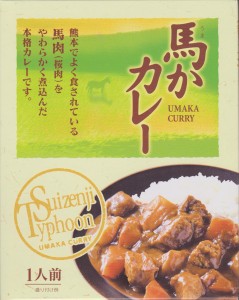 I’ve eaten basashi at izakayas a few times over the years, dipping slices of raw horse meat in soy sauce with grated ginger. Perhaps I haven’t gone to the right places, but I’ve found the meat to be overly chewy and not memorably flavorful. It’s not at all unpleasant, but it struck me as being in the category of things one eats just to say one has eaten them.
I’ve eaten basashi at izakayas a few times over the years, dipping slices of raw horse meat in soy sauce with grated ginger. Perhaps I haven’t gone to the right places, but I’ve found the meat to be overly chewy and not memorably flavorful. It’s not at all unpleasant, but it struck me as being in the category of things one eats just to say one has eaten them.
However, the horse meat curry I tried a few days ago was much nicer than that. It included chunks of what I would consider good stew meat – soft and just slightly stringy, easy to break up with the edge of a spoon. Some of the meat had little bits of tendon attached, with the collagen softened by long cooking. (I was content with the quantitiy of meat I got, but it was nothing like the generous mountain shown in the photo on the box.)
Around Japan in 47 curries: Iwate cheese
Tom Baker (Chiba, 1989-91) is writing a 47-part weekly series of posts on his Tokyo Tom Baker blog, in which he samples and comments on a curry from a different prefecture each week. Here’s an excerpt from his ninth installment, about Iwate Prefecture.
When I first came to Japan, I found some Koiwai cheese in a supermarket and mistook it for an American product. After all, Kiowa – as I initially misread the name – has an American ring. (The Kiowa are a Native American tribe.)
However, I now know the history of Koiwai cheese – and its unusual name – goes all the way back to the adventures of the Choshu Five, a group of young men who secretly left Japan in 1863 to study in Britain. After their return, they became leading figures in the country’s rapid modernization. One of them, Masaru Inoue, is remembered as “the father of the Japanese railways.”
In 1888, Inoue visited Iwate to inspect the progress of railway construction there. According to the Koiwai website, the volcanic soil and barren-looking windswept terrain struck him as a promising area for ranching…
Around Japan in 47 Curries: Toyama water
Tom Baker (Chiba, 1989-91) is writing a 47-part weekly series of posts on his Tokyo Tom Baker blog, in which he samples and comments on a curry from a different prefecture each week. Here’s an excerpt from his eighth installment, about Toyama Prefecture.
The Kurobe River is short but steep. It runs only 85 kilometers from Mt. Washiba in Toyama Prefecture, but it falls nearly 3 kilometers over that distance. Where it empties into the Sea of Japan, it has created an alluvial fan where the town of Kurobe stands. Because of its steep fall, the river was a good candidate for a hydroelectric project. The Kurobe Dam, Japan’s tallest at 186 meters, was built across it in a major postwar construction project from 1956 to 1963.
Although most famous as the site of an engineering feat, the Kurobe River is also known for the quality of its water, especially the cold springs that bubble up in the coastal town of Kurobe after filtering through the alluvial fan. It’s called Kurobe Meisui—literally, Kurobe’s famous water.
Today, I tasted one of several varieties of Kurobe Meisui curry – a black “soup curry” made with the famous water…
Akita mushroom curry
Tom Baker (Chiba, 1989-91) is writing a 47-part weekly series of posts on his Tokyo Tom Baker blog, in which he samples and comments on a curry from a different prefecture each week. Here’s an excerpt from his sixth installment, about Akita Prefecture.
 I would have identified the mushrooms in this curry as shimeji—a standard item at any Japanese supermarket—but the ingredient label described them more specifically as buna-shimeji, or beech shimeji…
I would have identified the mushrooms in this curry as shimeji—a standard item at any Japanese supermarket—but the ingredient label described them more specifically as buna-shimeji, or beech shimeji…
So it’s appropriate that I washed the curry down with some Buna no Mori (beech forest) beer, made with wild yeast originally collected in the forest. This 5-percent beer was slightly darker than a typical mass-produced Japanese lager, and had a flavor that was rich and strong…
Mackerel curry from Chiba Prefecture
Tom Baker (Chiba, 1989-91) has begun a 47-part weekly series of posts on his Tokyo Tom Baker blog, in which he will sample and comment on a curry from a different prefecture each week. Here’s an excerpt from his fourth installment, about Chiba Prefecture:
 On a visit to Choshi last year, I noticed many businesses that appeared permanently shuttered, including a hotel just a block from the town’s famous lighthouse. But Choshi does have a few things going for it. Two major soy sauce companies, Yamasa and Higeta, have factories there. And its history as a center of the fish cannery business led to the existence of this week’s curry: canned mackerel.
On a visit to Choshi last year, I noticed many businesses that appeared permanently shuttered, including a hotel just a block from the town’s famous lighthouse. But Choshi does have a few things going for it. Two major soy sauce companies, Yamasa and Higeta, have factories there. And its history as a center of the fish cannery business led to the existence of this week’s curry: canned mackerel.
Strawberry curry?
Tom Baker (Chiba, 1989-91) has begun a 47-part weekly series of posts on his Tokyo Tom Baker blog, in which he will sample and comment on a curry from a different prefecture each week. Here’s an excerpt from his third installment, about Tochigi Prefecture:
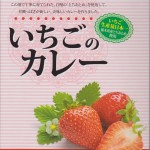 Toshogu may be the prefecture’s main historical attraction, but strawberries are its claim to fame in the agricultural field. It is Japan’s top producer of them. According the prefecture’s official tourism website, “Tochiotome, a large, sweet variety of strawberry with a vivid red color, represents Japanese strawberries. This variety is large in size and sweet, juicy and soft in taste.”
Toshogu may be the prefecture’s main historical attraction, but strawberries are its claim to fame in the agricultural field. It is Japan’s top producer of them. According the prefecture’s official tourism website, “Tochiotome, a large, sweet variety of strawberry with a vivid red color, represents Japanese strawberries. This variety is large in size and sweet, juicy and soft in taste.”
So, naturally there is a Tochigi strawberry curry – made with tochiotome strawberrries.
I’ll Make It Myself!: Veg* Out in Kanazawa: Aashirwad
L.M. Zoller (CIR Ishikawa-ken, Anamizu, 2009-11) is the editor of The Ishikawa JET Kitchen: Cooking in Japan Without a Fight. A writer, web administrator, and translator, ze also writes I’ll Make It Myself!, a blog about food culture in Japan; curates The Rice Cooker Chronicles, a series of essays by JETs and JET alumni on the theme of cooking/eating and being alone in Japan; and admins The JET Alumni Culinary Group in LinkedIn.
New Rice Cooker Chronicles submissions always welcome. Just e-mail it to jetwit [at] jetwit.com.
Aashirwad (アシワード)
Location: Kohrinbo, Kanazawa
Type: Indian/Nepalese; lunch, dinner
Veg status: vegetarian friendly
Languages: Japanese and English (menus, staff)
I’ll Make It Myself!: Curried Cauliflower with Tuna
L.M. Zoller (CIR Ishikawa-ken, Anamizu, 2009-11) is the editor of The Ishikawa JET Kitchen: Cooking in Japan Without a Fight. A writer and web administrator for The Art of Travel, ze also writes I’ll Make It Myself!, a blog about food culture in Japan, and curates The Rice Cooker Chronicles, a series of essays by JETs and JET alumni on the theme of cooking/eating and being alone in Japan.
New Rice Cooker Chronicles submissions always welcome. Just e-mail it to jetwit [at] jetwit.com.
I used to refer to cauliflower as “broccoli’s sad cousin.” Years of veggie trays at family functions taught me that dip does not make raw cauliflower taste good. A month of a “let’s try new vegetables” experiment in high school taught me that no amount of cheese will make me touch boiled cauliflower. (Seriously. There are some things even cheese can’t fix.)
At some point last year, everyone on the Internet seemed to having a foodgasm about using mashed cauliflower as an alternative to mashed potatoes, and as I was snarking away*, my husband revealed that he likes cauliflower.
Whoa whoa whoa. Back up there.

